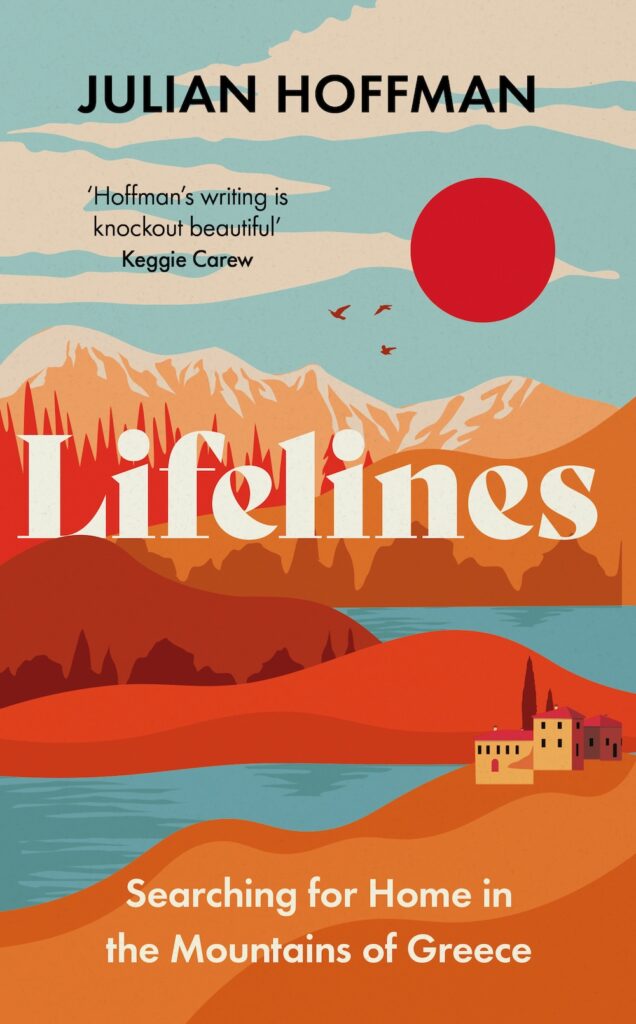In extract from Julian Hoffman‘s latest book ‘Lifelines’, out today, pelicans lend a palpable antiquity to the landscape of northern Greece.

On a small hill beside the lake, the March sun was warm on my skin. It was the vernal equinox and almost a week into the closure of the country. Shops, restaurants and cafés shuttered and still. Schoolchildren sent home and the streets eerily empty. Borders sealed amid the unfolding pandemic. A world of scrolling light on our screens, the lit figures unreal and rising.
It was the first day of spring. A beginning, but also an end.
I’d climbed through lengthening grasses to reach the top of the hill. Underfoot, the small white blades of star of Bethlehem split the damp earth. The changes felt sudden and unexpected, as though each circling of the year were still a surprise. Wild plum trees exploded into snow on the flanks of the hill and a drowsy billow of bees honoured the blossom. From the blue water below lifted the liquid laughter of little grebes. Somewhere to the west, an early cuckoo called its name.
From the top of the hill, I could see the evocative ruins of the basilica built over a thousand years earlier by Tsar Samuel of Bulgaria when he made the island of Agios Achilleios the capital of his once expansive kingdom. Beyond the basilica, large birds were gliding over the water towards an archipelago of small white islands beside the tawny sweep of an immense reedbed. Even within a vast basin of water, where encircling mountains reached high into the blue sky, these white islets dominated the scene. Most of the movement around the lake that day originated there. Pale brown and largely unnoticed for several months of the year, their bleaching meant that pelicans were with us again.
No matter how long I end up living beside the Prespa lakes in northern Greece, the presence of pelicans will never fail to move me. Not only does their grace in the air encourage a mysteriously durable form of awe, impervious to the kind of dulling that the repetition of experiences can often occasion, but they lend the landscape a palpable antiquity. Their flights convey something of another age, as though towing an invisible line behind them that reaches all the way back to the dinosaurs. There’s that slow oaring of the air on wings that have barely changed in structural essence since the bird’s earliest ancestors. Or the wondrous doubling of forms when skimming so low over the lake that you could barely slide a knife between the bird and its reflection. Taking advantage of an aerodynamic phenomenon known as ground effect, in which air flowing between the surface of the water and the surface of a bird’s wings creates an invisible cushion that keeps the pelican suspended mere inches above the lake, the great evolutionary aim to conserve energy whenever possible produces a simultaneously potent visual poetry. And in summer, when heat haze rises off the water in rippling waves of light, it’s hard not to imagine those pelicans being held in place solely by a spell.
Every spring I climb the hill to see these returning birds. But on that equinox day in 2020, the visit felt undeniably different. By then, Covid-19 was raging throughout southern Europe. Acutely attuned to the crippling financial crisis and stark economic con- traction that Greece had endured since 2009, there was an early consensus – both politically and among citizens – that the state’s fragile public-health system would swiftly collapse if case numbers rose rapidly. All week we’d heard that the closure of shops and schools wasn’t sufficient to quell the increase in transmission rates and that the implementation of a strict lockdown was imminent, placing severe restrictions on personal movement. In light of that prospect, I came to see the pelicans on their nests that day knowing it might be my only chance to see the colonies for a considerable period of time.
I heard a pelican hidden by the overhang of the hill. Uncloaking into view, it glided through the sharp, silvery light. Up close in my binoculars, the image of an earlier era only intensified. Dalmatian pelicans have eyes of such tremulous glacial depths – the bluish grey sclera like an ice sheet being cored by the black iris – that they appear to hold entire worlds inside them. And, in a way, they do. Like the great white pelican, the Dalmatian pelican’s brethren species that nests alongside it on this lake but arrives later in spring, these birds traverse broad valleys of oak and mountains thickened with beech trees and pines to reach here. They sail over remote upland villages and lonely, winding roads. They spiral high above the milky wash of deltas running quick with meltwater into the sea. They trace a geography of longing with those audible wings, because within each of these journeys is concealed a code. Something untranslatable by us. A string of genetic memory and meaning that brings them home each and every year to these islets on a Balkan lake, guiding them back across that expansive aerial map to the same place of shelter we share. And that spring, in a world so radically altered and uncertain, those journeys home and the constancy of connection they detailed resonated more deeply than ever.
*
‘Lifelines: Searching for Home in the Mountains of Greece’ is out now, published by Elliott & Thompson. Buy a copy here (£18.04).